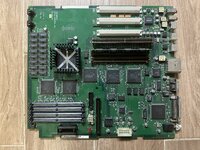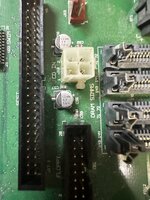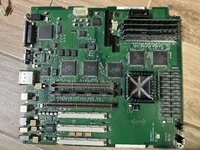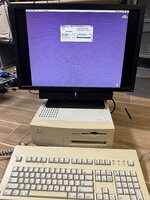3lectr1cPPC
Well-known member
I've finally gone and broken my streak of mostly only collecting laptops, and I picked up my first two desktop Macs in a long while from the recent VCF East Swap Meet. Those two were a Mac IIsi, and a Power Macintosh 7100. Both were sold to me as working, and I got both pretty cheap ($35 for the 7100, $50 for the IIsi). Now, some poor soul already recapped the IIsi so I won't have to. Wouldn't have bought it otherwise, you'll never catch me trying to recap a IIsi Power Supply. And as described, it chimes and outputs video just fine.
The 7100 on the other hand... did not do so, despite being sold to me as working. Ah well. Time to troubleshoot!
So, the symptoms:
Upon powering on, it would do a variety of things depending on the time. Strange things, things I've never heard described by anyone. Here's a list of all the states I saw it go into upon power attempts:
1. Chimes as normal. Only did this a couple times and I don't know if it outputted video at that time because my DB15 to VGA adapter hadn't come in yet.
2. No chime at all. This was the most common, and would always happen past the first couple attempts after being plugged in.
3. Delayed chime. This one's where it gets strange, never heard of any Mac ever doing this. Essentially, the PSU fan would click on, speaker pop, then nothing for about 10-15 seconds, then a chime. No video when this happened either.
4. Delayed broken chime. Many times did it have the delayed chime, then get stuck at the end of the chime and start repeating the same note endlessly. I did get this on recording so I'll upload that at some point.
5. Delayed chime followed by death chime.
I first tested the 5 and 12 volt rails from the PSU and found them to be completely spot-on. I think it was 5.06 and 12.04 or something to that effect. Incredibly accurate!
And so, the obvious thing to try next, a recap. I figured it would need one, and was planning one whether it worked or not, but pushed that plan ahead of course due to this issue. The caps on the board all looked great. Shiny pads, except for the 100uf 6v cap by the CPU, which looked a little dull. I also noticed some suspicious green corrosion on some of the CPU legs near that cap (!)
Now the 7100 is a real pain to recap for multiple reasons. The first being that there are a total of 26 SMD electrolytic caps on the logic board. That's a lot! More than just about any other Mac. The other annoyance is that many are strategically placed right near or in the middle of multiple plastic parts, just waiting to trip up an amateur solderer and cause a melted mess. And even for an experienced one - if you use hot air to get all the caps off, you're going to melt plastic, full stop. There's no good way around it. I know a lot of people don't like the twist method, but there really aren't a whole lot of better ways out there for a few of the caps on this board. With that being said, the twist method works great when done properly, and it's never let me down. And it didn't here either. In fact, the caps all came off the board incredibly easily. I'm talking one off every 5 seconds easy, they were very cooperative.


In the end, one cap had visible leakage - and it was indeed the 100uf cap. I got to it last by coincidence and that was the only time I smelled the awful fish smell during the recap.
I went with those cool looking red Wurth electrolytic caps as replacements for the 47uf caps because 25 tantalum caps are pretty expensive compared to the 20 cents per red cap. Did replace the single 100uf cap with a tantalum though. Soldering is decent overall I think. A couple joints that don’t look too good due to tight spaces and ground planes, but overall I think I did a good job with this one.

But was my problem fixed afterward? I'm happy to say that it was! Now it chimes quickly and consistently, outputs video, and happily boots Mac OS 7.5.5 off the hard drive it came with. Problem solved!

It's starting to become well known that the early Power Macs need their caps replaced, but I feel that many still have the "recap when necessary" approach in practice when it comes to these. I really don't think that's a good idea, for a few reasons.
1. The boards on these are so much more complex than on older 68k Macs. Traces are small, layers are many, and spotting and fixing corroded areas is not going to be an easy task.
2. At least in the case of the 7100, there are just so many of them! That's gonna cause a lot of damage when they all go.
3. The PowerPC 601 CPU is super fragile in just about every way, and I'll bet those pins won't take much abuse from cap goo before they break. Mine were already starting to corrode and there wasn't even any visible liquid leakage yet. That's a disaster waiting to happen, and that goes for any QFP 601-based Mac.
Get 'em recapped folks!
The 7100 on the other hand... did not do so, despite being sold to me as working. Ah well. Time to troubleshoot!
So, the symptoms:
Upon powering on, it would do a variety of things depending on the time. Strange things, things I've never heard described by anyone. Here's a list of all the states I saw it go into upon power attempts:
1. Chimes as normal. Only did this a couple times and I don't know if it outputted video at that time because my DB15 to VGA adapter hadn't come in yet.
2. No chime at all. This was the most common, and would always happen past the first couple attempts after being plugged in.
3. Delayed chime. This one's where it gets strange, never heard of any Mac ever doing this. Essentially, the PSU fan would click on, speaker pop, then nothing for about 10-15 seconds, then a chime. No video when this happened either.
4. Delayed broken chime. Many times did it have the delayed chime, then get stuck at the end of the chime and start repeating the same note endlessly. I did get this on recording so I'll upload that at some point.
5. Delayed chime followed by death chime.
I first tested the 5 and 12 volt rails from the PSU and found them to be completely spot-on. I think it was 5.06 and 12.04 or something to that effect. Incredibly accurate!
And so, the obvious thing to try next, a recap. I figured it would need one, and was planning one whether it worked or not, but pushed that plan ahead of course due to this issue. The caps on the board all looked great. Shiny pads, except for the 100uf 6v cap by the CPU, which looked a little dull. I also noticed some suspicious green corrosion on some of the CPU legs near that cap (!)
Now the 7100 is a real pain to recap for multiple reasons. The first being that there are a total of 26 SMD electrolytic caps on the logic board. That's a lot! More than just about any other Mac. The other annoyance is that many are strategically placed right near or in the middle of multiple plastic parts, just waiting to trip up an amateur solderer and cause a melted mess. And even for an experienced one - if you use hot air to get all the caps off, you're going to melt plastic, full stop. There's no good way around it. I know a lot of people don't like the twist method, but there really aren't a whole lot of better ways out there for a few of the caps on this board. With that being said, the twist method works great when done properly, and it's never let me down. And it didn't here either. In fact, the caps all came off the board incredibly easily. I'm talking one off every 5 seconds easy, they were very cooperative.


In the end, one cap had visible leakage - and it was indeed the 100uf cap. I got to it last by coincidence and that was the only time I smelled the awful fish smell during the recap.
I went with those cool looking red Wurth electrolytic caps as replacements for the 47uf caps because 25 tantalum caps are pretty expensive compared to the 20 cents per red cap. Did replace the single 100uf cap with a tantalum though. Soldering is decent overall I think. A couple joints that don’t look too good due to tight spaces and ground planes, but overall I think I did a good job with this one.

But was my problem fixed afterward? I'm happy to say that it was! Now it chimes quickly and consistently, outputs video, and happily boots Mac OS 7.5.5 off the hard drive it came with. Problem solved!

It's starting to become well known that the early Power Macs need their caps replaced, but I feel that many still have the "recap when necessary" approach in practice when it comes to these. I really don't think that's a good idea, for a few reasons.
1. The boards on these are so much more complex than on older 68k Macs. Traces are small, layers are many, and spotting and fixing corroded areas is not going to be an easy task.
2. At least in the case of the 7100, there are just so many of them! That's gonna cause a lot of damage when they all go.
3. The PowerPC 601 CPU is super fragile in just about every way, and I'll bet those pins won't take much abuse from cap goo before they break. Mine were already starting to corrode and there wasn't even any visible liquid leakage yet. That's a disaster waiting to happen, and that goes for any QFP 601-based Mac.
Get 'em recapped folks!
